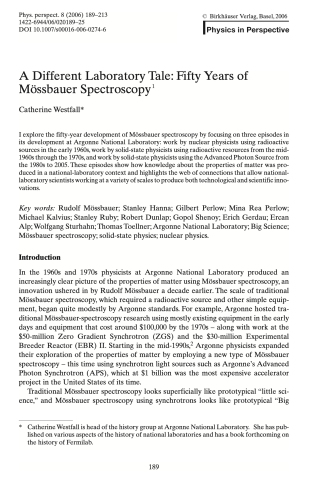A Different Laboratory Tale: Fifty Years of Mössbauer Spectroscopy

I explore the fifty-year development of Mössbauer spectroscopy by focusing on three episodes in its development at Argonne National Laboratory: work by nuclear physicists using radioactive sources in the early 1960s, work by solid-state physicists using radioactive resources from the mid1960s through the 1970s,and work by solid-state physicists using the Advanced Photon Source from the 1980s to 2005. These episodes show how knowledge about the properties of matter was produced in a national-laboratory context and highlights the web of connections that allow national laboratory scientists working at a variety of scales to produce both technological and scientific innovations.
In the mid-1960s, Mössbauer spectroscopy at Argonne entered a new phase that would provide another example of the development of small-scale research at a U.S. national laboratory. This new phase began when Michael Kalvius was recruited to the Solid State Science Division. Kalvius came to Argonne from Case Reserve (later Case Western Reserve University) in Cleveland, Ohio, but he got his start at the Technical University of Munich doing a Ph.D. thesis on Mössbauer spectroscopy just a few years after Mössbauer. By the time Kalvius came to Argonne in 1965, Hanna had left Argonne and had been replaced by a former Westinghouse physicist, Stanley Ruby. Although Argonne’s Solid State Science Division included theorists Kundan Singwi and A. Sjölander, who published the first comprehensive theory of the Mössbauer effect in 1960, the Solid State Science Division had not hosted a large effort in Mössbauer spectroscopy before the mid-1960s, and experimentalists in the Physics and Solid State Science Divisions had not interacted much.This pattern changed when Kalvius and Ruby began working together. In the next two years their collaboration expanded to include others, including two young solid-state physicists, Bobby Dunlap and Gopal Shenoy, the latter of whom had earned his Ph.D. degree at the University of Bombay.29
Perlow’s experience revealed that national-laboratory physicists can get highly skilled help next-door; the Ruby-Kalvius-Dunlap-Shenoy collaboration showed the potential of intellectual cross-pollination when members of two national-laboratory Divisions join forces. By the mid-1960s, this team, consisting of a nuclear-physicist turned solid-state physicist, a nuclear physicist from industry, and two young, energetic and enthusiastic solid-state physicists, were in a prime position to build on Argonne’s nuclear-physics expertise to exploit the remaining nuclearphysics insights as well as the rich solid-state physics inherent in the hyperfine interactions that connect nuclear moments with solid-state properties.
,Their collaboration also would provide “a new turn” in Mössbauer spectroscopy at Argonne, as Shenoy noted and as division progress reports confirm. The unprecedented ultra-high resolution of Mössbauer spectroscopy gave solid-state physicists the opportunity to make a broad range of hyperfine-structure measurements – Shenoy would remember later that they measured about 10,000 compounds. Solid-state physicists could add this hyperfine-structure information, which Shenoy judged to be “the most important data point,” to the mix of other data, such as measurements of electronic and magnetic properties and measurements of thermal and electrical conductivities, to piece together the vastly complicated picture of the magnetic, thermal, electronic, and mechanical properties of a large variety of materials.This new data was crucial because solid-state physicists depended upon a large quantity of high-quality information to achieve the key goals of their field: delineating the basic properties of matter and finding materials suitable for researchers in other fields as well as various industrial applications that they hoped would “revolutionize industrial science.”30
As the stock of Mössbauer spectroscopy rose in the Solid State Science Division, it fell in the Physics Division, where many judged that the technique had already yielded the key insights of interest to nuclear physicists. Although Perlow, Ruby, and some other nuclear physicists continued using Mössbauer spectroscopy, the mid-1960s through the 1970s marked the evolution, in Shenoy’s words, “from a discovery era” aimed primarily at exploring nuclear properties “using a few resonances in the Physics Division to an applications era using a large Mössbauer periodic table in the Solid State Science Division.”31